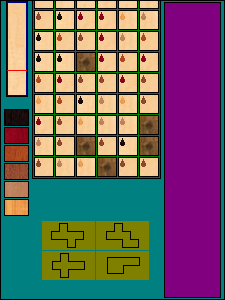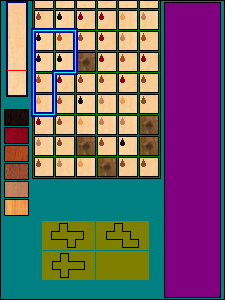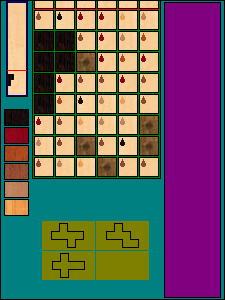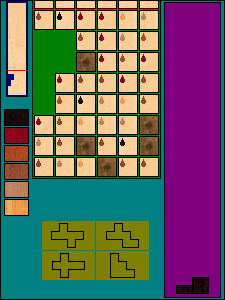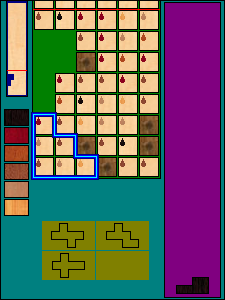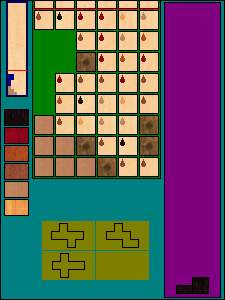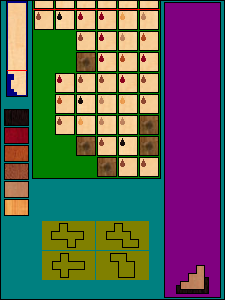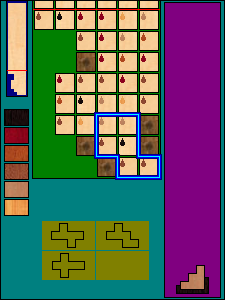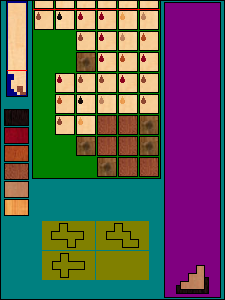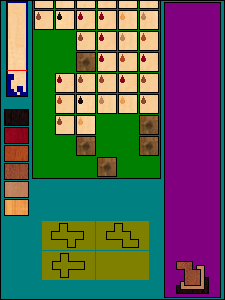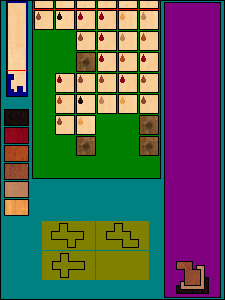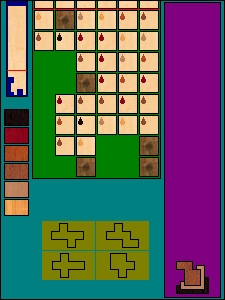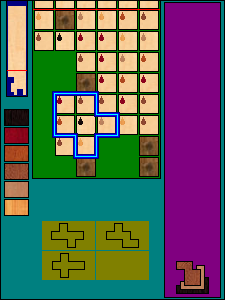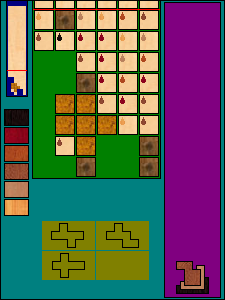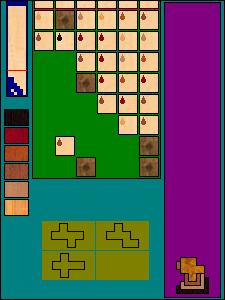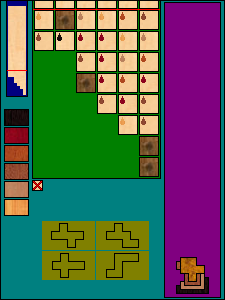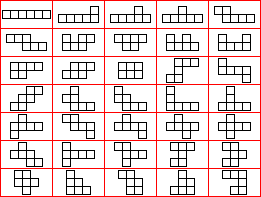GCPP:Proposal-Mullet
Puzzle Codename: Mullet
| Contact | |
| Username: | Nekura_Ca |
| Additional contact info: | Nekura on Viridian, nekura.ca@gmail.com |
| Project forum thread: | Codename:Mullet |
Game concept
Similar elements to Carpentry and Shipwrightery.
Objective
To cut a piece of wood into the specified shapes, minimizing waste, and maximizing value.
Gameplay
The board starts with a square grid 6x8 covered with wood, with more leading in from the top, and each square will have a varnish drop on it. At the bottom will be a set of four outlines of shapes, made up of six connected squares. There are a total of 35 shapes that can be formed with six squares.
During play, the player selects one of the shapes, and can flip and rotate it to position it as needed (see carpentry, for example). They then selects a place on the board to cut the shape out of. The entire piece must be wood, it cannot include empty spaces, or overhang the edge of the board. Once cut, the wood is removed from the board, not replaced, and a new random shape will replace the cut piece at the bottom. Any pieces not still connected to the top of the board drop, and are wasted. If the bottom row is empty, the board advances, with all remaining pieces moving together, until the bottom row is filled.
When a piece is cut, it is varnished the colour of the most plentiful of the varnishes that are on the squares, with ties going to the lowest valued varnish. The darker the varnish, the more valuable the piece. Cutting a piece with all six varnishes, though, will varnish it a golden colour, which is worth the most.
Scoring
The player will score points for the varnish colour of the shapes cut, and for getting long sequences without droping waste pieces. Cutting pieces that get the same varnish colour will score the "Double, Triple, Bingo, Donkey, Vagas..." sequence.
Scoring:
Varnish(v), scored by colour, knothole = 0, gold = 7, range 0 - 7
Sequence(s), total number of pieces cut since last waste, range 1+
Multiplier(m), total number of pieces of the same colour since last waste, gold counting as wild, range 1+
Waste(w), number of squares wasted by this cut, range 0+
Piece Score = (v * s * 2^(m-1))/(w + 1)
Other options: Replace 2^(m-1) with m^2: This options makes chains a whole lot more valuable, since m^2 > 2^(m-1) for m<7, but I think that not wasting wood should be more important, and chains of more then 7 are probably going to be extreamly rare.
Replace /(w + 1) with -w*x (x being an arbitrary value determined later): a simple penalty for wasting wood, rather then dividing the score, would mean that continuing a large combo with some waste would be a useful option, but this way, too much waste could totally negate any chain bonus currently built up. (could use -w^2, as well)
This is just an sample of scoring, there could be other options as well.
Variability
Special pieces:
- Knot pieces: if included in a cut piece, will cause it to be worthless, but if dropped as waste, will not affect the score;
- Cracks: the edge between two squares on the board may be cracked, meaning the two pieces cannot be used in the same shape.
End criteria
The entire board will be 35 rows long, and the game is over when the entire board is cut, or the player cannot make a move in the current board.
Difficulty scaling
Start with three colours of varnish, working up to the fill six. Density of knots and cracks will increase.
Crafting type
Furnishing
Known problems
Depending on the board size, players may quickly run out of placements, and booch very early.
Notes
Mockups to come soon.
Images
This is what the player will see when he starts (50% mock-up (coloured areas should be replaced by artwork)):
The central area is the board to be cut, each square has a varnish colour associated with it (the vanish colours should probably be more distinct, which should happen when resized, otherwise more distinct colours can be choosen) except the knotholes. The left is a progress track, as the player plays the game, the diagram will be cut down accordingly; and a ranking of the varnish colours, for reference. Along the bottom are the current target shapes. The box on the right will collect finished pieces, so the player can gauge how well they are doing along the way.
Not shown here yet are cracks.
Storyboard:
First Turn:
The knots at the bottom make it difficult to effectively use the wood without waste, so the player decides to use the dense packing of the best varnish up in the left corner to get good points at the start. They take the lower right shape, position it as shown, and has three '6' varnishes, two '4' varnishes, and a '1' varnish contained, so the majority '6' takes it, and it gets varnished, and removed. The board does not get replenished, but a new target shape shows up. Score = 6*1*2^0/1 = 6
Second Turn:
The new piece fits around the knotholes on the left, and contains varnishes 1, 2, 2, 3, 3, and 5. Since the 2s and 3s are tied, the lowest value varnish (2) is use. Score = 2*2*2^0/1 = 4
Third Turn:
Around the right hole, the piece covers 2, 2, 3, 3, 3, and 6, so is varnished 3. The removal of this piece causes the knot hole at the bottom to be disconnected, so it drops off. Since the lowest row is now empty, the board shifts down, and brings a new row into play. Score = 3*3*2^0/1 = 9
Fourth Turn:
This new piece allows the player to get all six colours into the one piece, so they get a gold varnish, but it also disconnects a good piece of wood, which is wasted. Score = 7*4*2^1/2 = 28 (note that the wasted wood cancles out the chain bonus for the wild gold)
Continuing:
None of the new pieces can be placed effecently, so now the player has to be careful about the next move, as they could take a piece with a knot, worth nothing, but not wasting anything, droping more good wood to get new rows, or just taking a good piece, and hoping to get a new piece that fits.
Other Images:
This is a diagram showing all of the shapes that are possible:
